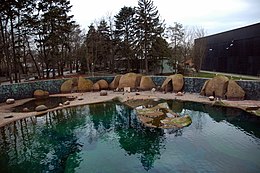Wrocław Zoo
| Wrocław Zoo | |
|---|---|
 Logo of the Wrocław Zoo | |
 The main entrance | |
 | |
| 51°06′16″N 17°04′27″E / 51.10444°N 17.07417°E | |
| Date opened | 1865, 1927, 1948 |
| Location | Wrocław, Poland |
| Land area | 33 hectares (82 acres) |
| No. of animals | ~10,500 |
| No. of species | 1,132 (2016) |
| Annual visitors | 2,000,000 |
| Memberships | EAZA,[1] WAZA[2] |
| Major exhibits | 12,000 |
| Director | Radosław Ratajszczak |
| Website | zoo |
The Wrocław Zoological Garden (
The Wrocław Zoo is the most visited zoo in Poland and the fifth most visited zoo in Europe.[4]
The zoo is an accredited member of the European Association of Zoos and Aquaria (EAZA)[5] and the World Association of Zoos and Aquariums (WAZA).[6]
History
The beginnings of the zoo date back to 1863 when the decision to establish a zoological garden in Breslau was made at the initiative of a local community. The city authorities designated 9 hectares of land by the

The zoo enjoyed considerable popularity among the inhabitants of Breslau despite a relatively limited variety of animals to be seen. The first elephant was bought in as late as 1873. It was an African elephant named Theodor and was transported from the London Zoo. It instantly became one of the biggest attractions of the zoo in Breslau.[7][9] In later years, the garden also acquired such animals as an anteater, eared seals, and penguins. Among other favourite animals of the zoo were chimpanzee Moritz and gorilla Pussy which arrived in the city in 1897 from Liverpool. A commemorative statue devoted to her can still be found to this day in the Wrocław Zoo.[8]
One of the biggest breeding successes of the zoo was the birth of the first in the world Malayan tapir, and in the Interwar period a hippopotamus named Anton. The zoo could also boast Muschi, the only Amazonian manatee in Europe, which died in the winter of 1945 (it lived for nine years).[9]

After the
After the
In 1997, the nearby Oder River overflowed, causing the zoo to be nearly damaged by a flood.[9]
In the second half of the 20th century, the Wrocław zoo achieved great success thanks to a popular
In 2006, Radosław Ratajszczak, previously working at the
Attractions and activities
The zoo includes among others: the Africarium (the only oceanarium of its kind which focuses exclusively on the fauna of Africa), the Madagascar Pavilion, the Odrarium, Terrarium, Zoolandia ropes course, Children's Zoo, the Ranch, as well as food and drinks outlets.
Moreover, it houses a collection of a number of rare and exotic species such as
The zoo's breeding program has also had a number of major successes, which include the births of Pygmy hippopotamus in 2010 and 2012,[12] Philippine scops owl (the only one in the world outside of the Philippines), reticulated giraffe in 2012[13] as well as the first in the world Sulawesi bear cuscus in 2018.[14]
List of directors

- Franz Schlegel (1864-1882)
- Hermann Stechmann (1882-1900)
- Friedrich Grabowsky (1900-1929)
- Hans Honigmann (1929-1934)
- Martin Schlott (1934-1946)
- Karol Łukaszewicz (1947-1966)
- Antoni Gucwiński (1966-2006)
- Radosław Ratajszczak (2007–present)
Gallery
-
Japan Gate
-
Africarium-Oceanarium (exterior)
-
Africarium-Oceanarium (interior)
-
"The Bear Fortress"
-
Building of the management
-
A meerkat in Wrocław Zoo
-
A terrarium building at the Wrocław Zoo
-
The Seal Centre
-
Carolina anole
-
Cyphotilapia frontosa, a species of fish endemic to Lake Tanganyika
See also
Notes
- ^ "EAZA Member Zoos & Aquariums". eaza.net. European Association of Zoos and Aquaria. Retrieved 12 August 2010.
- ^ "Zoos and Aquariums of the World". waza.org. World Association of Zoos and Aquariums. Retrieved 9 November 2010.
- ^ Wielkie liczenie w zoo we Wrocławiu. Zobacz, ile zwierząt w nim mieszka
- ^ "Europe's Most Popular Zoos: Top 35". ZooChat. Retrieved 2018-08-19.
- ^ "Where are EAZA members located?". Retrieved 25 September 2022.
- ^ "WAZA members". Retrieved 25 September 2022.
- ^ a b "150 lat temu otwarte zostało wrocławskie zoo. Historia tego ogrodu była bardzo burzliwa". Retrieved 2018-08-25.
- ^ a b c "Zoo we Wrocławiu obchodzi 150-lecie!". Retrieved 2018-08-25.
- ^ ISBN 1-57958-174-9.
- ^ "65 lat zoo w polskim Wrocławiu". Retrieved 2018-08-25.
- ^ "About the ZOO". Retrieved 2018-08-19.
- ^ "Powiększyła się rodzina hipopotamów". Retrieved 2018-08-25.
- ^ "Wrocław: W zoo urodziła się żyrafa". Retrieved 2018-08-25.
- ^ "Światowa sensacja we wrocławskim zoo". Retrieved 2018-08-25.
References
- L. Solski, 2008: Przewodnik Zoo Wrocław.





















